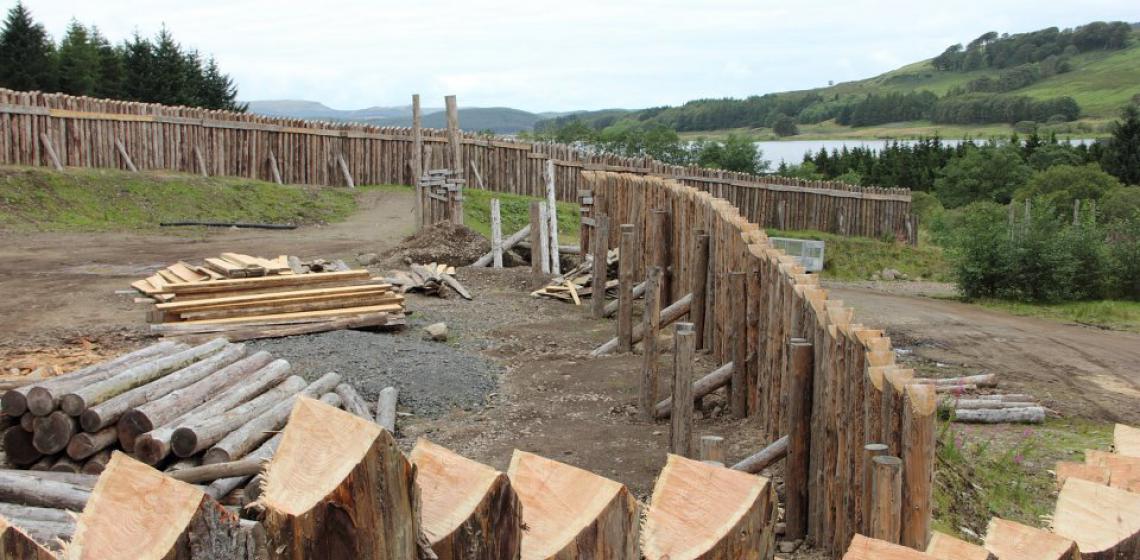Duncarron Medieval Village (UK)

It started life as a drawing scribbled on a beermat. An image of a museum without glass display cabinets, without boundaries. A museum with fully interactive exhibits that would teach about Scotland’s past.
Fifteen years later that drawing is becoming a reality as Duncarron a fully fortified Medieval Village situated beside the Carron Valley Reservoir and the men sitting around the table that night have become a recognised charity, The Clanranald Trust for Scotland (The Trust).
Once the decision had been made to build the village they consulted Archaeologists, Historians and Architects as to the feasibility and historical accuracy of building a village based on an 11th Century motte and bailey design. Ignoring all the obvious barriers, they then set about putting their plan into action.
Denied funding, they hired a hall, recruited friends and advertised in the local paper for likeminded people to join them. Using their background in martial arts they adapted it to medieval fighting techniques and trained their new members. This enabled them to hire themselves out as warriors and educators, any money raised initially going towards expenses and new equipment. As the number of volunteers grew they were able to put money towards the cost of the Duncarron project.
Eventually, in 2000 they obtained the long term lease of land in the Carron Valley (hence the name Duncarron) from the Forestry Commission. Now there was rent to pay, building materials to buy and diggers to hire. They needed to double their fundraising efforts. Finally in February 2008 the first log of the palisade was put in place.
From a small group of friends with a shared vision, The Trust has evolved into a large group of volunteers, including a branch in England and associated members and groups spread over the world. This allows for groups of volunteers to carry out the weapon displays, film work and education visits, while another groups concentrates on the building of Duncarron. All groups of volunteers helping each other out as and when necessary.
To build a fortified village requires more than just money and materials and knowledge of construction and carpentry. It requires the ability to persuade people to believe in your dream, the ability to see setbacks as a learning experience and not as impassable barriers. Mostly it calls for a large amount of manpower. Therefore other groups of volunteers or professionals help. Amongst these other groups are a detachment of the Territorial Army who spend the odd weekend camping at the fort site digging ditches, building the palisade and any other jobs that their state of the art equipment can make easier.
Currently the Trust operate 4 days per week placements for Community Service and Community Payback orders. Since we started this in 2008 it has been an often challenging but very rewarding experience but for us and for the user groups.
Duncarron will have multiple roles, as well as a living museum it will be used as a venue for companies to entertain their employees or clients or for other functions such as weddings.
The film and television industries may also be interested in using Duncarron as a set. In its main role the village will be home to a variety of people from different walks of medieval society, from the chief down. The Villagers will carry out crafts and trades from medieval Scotland from metalworking, weaving and pottery to dyeing. There will also be a working blacksmith forge to produce the weapons and other tools of the time for use in the fort. Part of the Village will become a ‘Warriors Training Camp’ where members of The Trust can hone their fighting skills and members of the public see the weapons of the time in use. One of the buildings will be unfinished so as visitors can see the techniques used in its construction. With all exhibits being fully interactive it is hoped that visiting school groups, families and individuals will fully experience the atmosphere of a Medieval Village.
Text source: Duncarron website
Image by The Clanranald Trust for Scotland - privat übersandt, CC BY-SA 3.0, https://commons.wikimedia.org/w/index.php?curid=16900366
